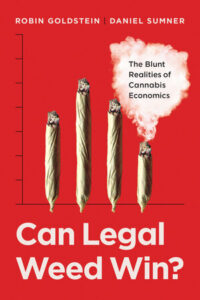Two economists take readers on a tour of the economics of legal and illegal weed, showing where cannabis regulation has gone wrong and how it could do better.
Cannabis “legalization” hasn’t lived up to the hype. Across North America, investors are reeling, tax collections are below projections, and people are pointing fingers. On the business side, companies have shut down, farms have failed, workers have lost their jobs, and consumers face high prices. Why has legal weed failed to deliver on many of its promises? Can Legal Weed Win? takes on the euphoric claims with straight dope and a full dose of economic reality.

This book delivers the unadulterated facts about the new legal segment of one of the world’s oldest industries. In witty, accessible prose, economists Robin Goldstein and Daniel Sumner take readers on a whirlwind tour of the economic past, present, and future of legal and illegal weed. Drawing upon reams of data and their own experience working with California cannabis regulators since 2016, Goldstein and Sumner explain why many cannabis businesses and some aspects of legalization fail to measure up, while others occasionally get it right. Their stories stretch from before America’s first medical weed dispensaries opened in 1996 through the short-term boom in legal consumption that happened during COVID-19 lockdowns. Can Legal Weed Win? is packed with unexpected insights about how cannabis markets can thrive, how regulators get the laws right or wrong, and what might happen to legal and illegal markets going forward.

Robin Goldstein is an economist and author of The Wine Trials, the controversial exposé of wine snobbery that became the world’s best-selling guide to cheap wine. He is Director of the Cannabis Economics Group in the Department of Agricultural and Resource Economics at the University of California, Davis. He has an AB from Harvard University, a JD from Yale Law School, and a PhD in economics from the University of Bordeaux.
Daniel Sumner is Frank H. Buck, Jr. Distinguished Professor of Agricultural and Resource Economics at the University of California, Davis. He grew up on a California fruit farm, served on the president’s Council of Economic Advisers, and was Assistant Secretary of Economics at the US Department of Agriculture before joining the UC Davis faculty. He has a BS from Cal Poly and a PhD in economics from the University of Chicago.
Why is legal weed failing to measure up from an economic standpoint?
Number one: legal weed is much more costly to grow and market than illegal weed. This is mostly because of taxes, regulations, license fees, and bureaucratic requirements for running a legal weed business. Illegal weed of similar quality is just a lot cheaper for consumers. Legal weed producers and sellers face extensive safety, environmental and social regulations, and need lawyers, consultants, and staff with expertise at dealing with local and state governments. Number two: There are many restrictions on where and when legal weed can be sold. Some cities and counties prohibit legal weed businesses entirely, and the places that allow them often place serious restrictions on their operations. For instance, in California, weed can’t be legally sold after 10 pm in California, so all midnight weed is illegal weed. Illegal weed is available all the time and just about everywhere. It has other problems but ends up cheaper and more plentiful than legal weed. Only a few states have allowed legal weed prices to be truly competitive with illegal weed.
What would a smarter and fairer legal weed market look like?
We cannot get to an ideal. There are always trade-offs with winners and losers. But, legal weed can win with smarter and fairer rules governing the market. First, we must accept that weed is everywhere and has been for a long time. Every time we restrict when and where legal weed is sold and who can sell it, we must ask: how does this restriction help illegal weed, and is that what we want? Every time we cause legal weed to be more costly, we need to ask: how much does that help illegal weed? We will have a smarter and fairer market when legal weed is cheaper, better, and more available than illegal weed.
Why is the term “legalization” misleading?
First, to call what we have done “legalization” misleads producers, consumers, and the public because most weed consumed is still sold illegally! Second, many sellers who used to sell medical weed openly, without many restrictions, have now been driven to the illegal market. Legalization can mean so many different things: removal of criminal penalties for possession is the most basic level, but that’s more accurately called “decriminalization.” Legalization of selling weed can be medical legalization, where sale is only legal to state residents with medical recommendations; or it can be broader “recreational” or “adult-use” legalization, where it’s legal to sell to any adult above a certain age. We have learned that recreational “legalization” can be more restricted than medical legalization, depending on the specifics of regulations governing when, where, and how weed can be sold and how much it is taxed.
What can be done to spread the benefits of legalization across all communities?
Some states have made early mistakes in their approaches to legalization. One benefit of the differences in regulation around North America is that places can learn from each other’s successes and failures. For example, Vermont, which has yet to allow a single successful cannabis retailer four years after voters passed legalization, seems an unlikely source for guidance. Oklahoma, where dispensaries opened the morning after the ballot question was approved by voters and legal medical weed is cheap and more plentiful than illegal weed, may have a system that’s useful for other states and local regulators to study and emulate.
Why do some people prefer weed from government-approved outlets?
Some people prefer legal weed because it’s tested for safety, potency, and meets other standards for consistency from batch to batch. It also has informative labels and child-safe packaging. In some places, legal weed may seem more easily available to some consumers—in the mall or down the street in a well-lit store or from a delivery service advertised along the highway. But these features are not for everyone, and many buyers already know what they want and what they will get from their traditional (illegal) retailer who is easy to find even without public displays. The legal advantages appreciated by some buyers often come at a high price—double or even triple the illegal price for a comparable product—and safety and consistency don’t matter as much to everyone. These days, there’s increasingly attractive packaging, good consistency, and even some testing in the illegal weed market too. (These illegal sellers know how to compete and have not been idle.) So, the bottom line is that buyers with plenty of money, those without connections, and those who want a specific and special product tend to favor the legal market.
Has weed legalization reduced the number of people in prison for weed offenses?
In short, yes. In many places along with legal possession, people who were in jail for minor weed violations were released, and possession no longer gets someone locked up. But legal weed possession doesn’t mean people stop going to jail for weed-related offenses. It’s a serious crime to sell weed without a license and possession of large quantities can still be a major problem. In California, for instance, unlicensed sale is punishable by up to 6 months in jail. Of course, federal law enforcement is still an unpredictable patchwork, and there’s also a risk of federal incarceration, even in some states with legalization—especially for those selling outside the legal market or transporting across state
